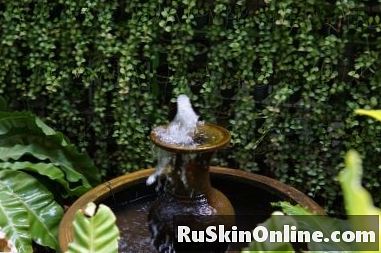
Content
- Successful garden design with fountains
- Simple fountains
- Pebble fountain
- millstone fountain
- Integrate fountains in the garden
- Tips

Even small fountains have a great effect
Successful garden design with fountains
There are numerous ways to bring small or even larger amounts of water in a refreshing and decorative way for bubbling, flowing or trickling. Fountains have been enjoying great popularity for centuries and find their place in a variety of designs not only in spacious, but also in small gardens their place.
Simple fountains
It does not always have to be the typical replicas of traditional wells, because other elements made for moving water.
Pebble fountain
For example, a collection of round pebbles is a popular base over which water can flow slowly. A pebble fountain is easy and enjoyable, and you do not need a pond for this solution. All you need is a sufficiently large tank for a submersible pump. This tank must be able to hold enough water to replenish the amount of water which evaporates from the pebble surface on a sunny day. The container size depends on how often the system is filled up - often even a simple plastic bucket is enough.
millstone fountain
A large millstone has a great architectural effect and should therefore be placed carefully in a place where it is opposed by another eye-catching element. The water runs over the side of the stone and is trapped in a container below it, which is why no pool is necessary here. A geyser nozzle can bring air into the element, if you like the bubbling effect of a fountain.
Integrate fountains in the garden
Narrow jets of water spurting from an informal pool can sometimes be very effective, but fountains tend to be more suitable for even arrangements. Stone fountains fit into a symmetrical equilibrium, such as slotted paths, trimmed hedges and straight edges. In small, enclosed medieval gardens paved paths often led to a fountain in the middle. On the other hand, you do not need much space to integrate a fountain into the garden: in narrow areas there is almost always a vertical surface for a separate, wall-mounted fountain.
Tips
Not only the shape of the fountain, but also its nozzle has an influence on the garden design, because there are different nozzle types with different beam effect. A fountain with a bell-shaped jet can be very pretty as the center of a quiet, enclosed garden. In an unprotected, windy location, however, the falling water would lose its uniform bell shape.